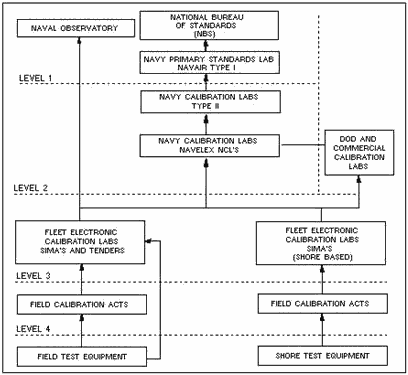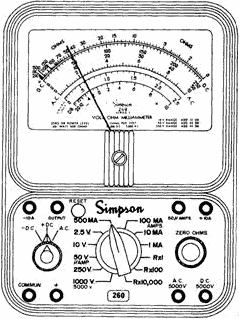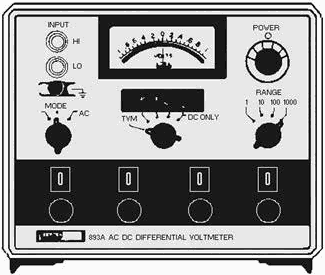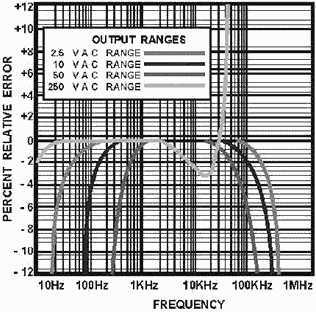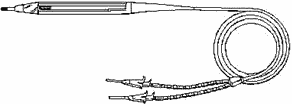Module 21 - Test Methods and Practices |
||||||||||||||||||||||||||||||||||||||||||||||||||
|
Module 21 − Test Methods and Practices
Pages i , 1−1, 1−11, 1−21, 2−1, 2−11, 2−21, 2−31, 2−41, 3−1, 3−11, 3−21, 3−31, 4−1, 4−11, 5−1, 5−11, 5−21, 5−31, AI−1 to AI−3, Index
Chapter 1
Basic MEASUREMENTS
Learning Objectives
Learning objectives are stated at the beginning of each chapter. These learning objectives serve as a preview of the information you are expected to learn in the chapter. The comprehensive check questions and answers are based on the objectives and enable you to check your progress through the reading assignments. By successfully completing the OCC/ECC, you demonstrate that you have met the objectives and have learned the information. The learning objectives for this chapter are listed below.
Upon completion of this chapter, you will be able to do the following:
1. Explain the importance of performing basic electronic measurements.
2. Explain the importance of voltage measurements in troubleshooting.
3. Identify the various methods of performing voltage measurements.
4. Identify the various methods of performing current measurements.
5. Identify the various methods of performing resistance measurements.
6. Identify the various methods of performing capacitance measurements.
7. Identify the various methods of measuring inductance.
Introduction to MEASUREMENTS
In today's modern Navy, a large part of a ship's, submarine's, or aircraft's ability to complete its mission depends on the efficiency of sophisticated electronic systems. As the technician responsible for these systems, you are the focal point in ensuring their reliability. In the event of a system failure, it is your responsibility to repair the system and to do so in a timely manner. Whether you are troubleshooting a faulty system or performing preventive maintenance, you are required to perform basic electronic measurements on a regular basis. This chapter will acquaint you with various alternative methods of performing measurements and discuss the relative merits and demerits of each method.
No discussion of electronic test equipment or electronic measurements would be complete without mentioning the Navy's Metrology Calibration (METCAL) program. Figure 1-1 shows the METCAL structure. Basically, the METCAL program is an elaborate quality control system designed to compare your electronic test equipment with test equipment of much greater accuracy. When you submit your piece of test equipment for calibration, it is compared with the calibration laboratory's equipment (referred to as STANDARDS), which are generally at least four times more accurate than yours. If your equipment does not meet specifications, it is either repaired, adjusted, or rejected with an explanation of why the calibration laboratory was unable to calibrate it. The accuracy of equipment at your local calibration laboratory is ensured by calibration of the test equipment to the standards of the next higher echelon calibration laboratory. The accuracies of test equipment at each higher echelon is increased by a ratio of approximately 4 to 1.
Figure 1-1. - Calibration laboratory structure.
METCAL provides assurance that your test equipment is in top-notch shape. Remember, your measurements are only as accurate as your test equipment; be fully aware of the limitations of your test equipment and never use equipment that isn't properly calibrated when performing measurements or adjustments.
Q-1. What assures the accuracy of your electronic test equipment?
Now that we have discussed the advantages of calibrated test equipment, let's review the reason for all this concern. The fundamental electrical quantities of a circuit are voltage and current and are dependent on the circuit characteristics of resistance, capacitance, and inductance. In addition to these three individual characteristics, don't forget that many electronic components exhibit more than one circuit characteristic at the same time. An example would be a piece of coaxial cable that is engineered by its manufacturer to meet characteristic specifications for impedance, capacitance, and inductance. But let's keep it simple and begin by covering voltage measurements.
Operation and use of common test equipment was covered in NEETS Module 16, Introduction to Test Equipment, NAVEDTRA B72-16-00-95. It is recommended that you review this module before continuing.
Voltage MEASUREMENTS
Most Navy technical manuals provide voltage charts that list correct voltages at all primary test points in a piece of equipment. Voltage measurements, when compared with these charts, provide a valuable aid in locating troubles quickly and easily. However, if the sensitivity of the test equipment differs from that of the test equipment used in preparing the chart, the voltage measurements may not reflect true circuit conditions. You must keep in mind that a voltmeter with low sensitivity used on a low range may disturb circuits under test or provide a false indication. Most technical manuals will tell you what type and model of test equipment was used to prepare the voltage charts. As a rule of thumb, the input impedance of the voltmeter should exceed the impedance of the circuit by a ratio of at least 10 to 1. Technicians have spent uncounted hours of wasted time because they have selected improper test equipment.
Q-2. The input impedance of your test equipment should exceed the impedance of the circuit under test by what ratio? DC Voltage MEASUREMENTS
Direct current voltage may be steady, pulsating, or have ac superimposed on it. The average value of a dc waveform depends on the symmetry of the wave and other aspects of the wave shape. It can vary from 63.6% of peak value for a rectified full sine wave to 50% of peak value for a triangular wave. For a superimposed sine wave, the average value can be zero. Regardless of whether the dc is steady, pulsating, or the ac is superimposed on the dc, a rectifier form of measuring device will indicate its average value.
Voltages are usually measured by placing the measuring device in parallel with the component or circuit (load) to be measured. The measuring device should have an infinite internal resistance (input impedance) so that it will absorb no energy from the circuit under test and, therefore, measure the true voltage. The accuracy of the voltage measurement depends on the total resistance of the measuring device compared to the load being measured. When the input impedance of the measuring device is 10 times greater than the load being measured, the error usually can be tolerated. If this error cannot be tolerated, a high input impedance measuring device, such as a vacuum tube voltmeter (vtvm), should be used. Alternatively, using two voltmeters in series increases the voltage range and, because of the increase in total voltmeter resistance, provides a more accurate measurement of voltage across the load. If the voltage to be measured is sufficiently high, more than two similar voltmeters can be connected in series across the load to provide greater accuracy; the total voltage measurement is the sum of the individual meter indications.
Q-3. What are the advantages of using two voltmeters in series?
Multimeter Method
a common piece of test equipment used in the Navy is the Simpson 260 analog multimeter, as shown in figure 1-2. It is capable of measuring both ac and dc voltages of up to 5,000 volts.
Figure 1-2. - Simpson 260 multimeter.
Two obvious advantages of the Simpson 260 are its portability and ease of operation. Among its disadvantages are its low input impedance and the inherent low accuracy associated with D'Arsonval meter movements, which are used in the meter. When performing measurements with any analog multimeter, remember that the most accurate readings are taken with the pointer midscale. You should also be aware of inaccuracies introduced as a result of parallax. PARALLAX is defined as the apparent displacement of the position of an object because of the difference between two points of view. In the case of meters, this means the position of a meter's pointer will appear to be at different positions on the scale depending on the angle from which the meter is viewed. Some of the Simpson 260 and 270 series multimeters have effectively eliminated the problem of parallax by incorporating a mirror on the scale that accurately reflects the position of the pointer of the meter movement.
Q-4. At what point on a meter movement are the most accurate readings taken?
Oscilloscope Method
A dc voltage measurement can be made with an oscilloscope, as shown in figure 1-3, that has a direct-coupled deflection amplifier or terminals for connection directly to the deflection plates of the cathode-ray tube. Measuring a dc voltage with an oscilloscope is convenient only under certain circumstances; for example, when other measurements are being made on the same equipment with the oscilloscope or when a vacuum tube voltmeter is not available and a high-impedance measuring device is required.
Figure 1-3. - Dual-trace oscilloscope.
Oscilloscopes have a high input impedance and normally will not load down the circuit under test. However, oscilloscopes are primarily designed for waveform observation and are typically less accurate than other pieces of test equipment used to measure dc voltages. a distinct advantage of the oscilloscope is its ability to monitor the level of ac ripple voltage riding the dc voltage. This feature makes the oscilloscope an indispensable aid in troubleshooting dc power supplies with excessive ripple caused by component failure.
Digital Multimeter Method
Most analog voltmeters (that use D'Arsonval meter movements) in common use today are accurate to approximately ±2% of full-scale reading. Most digital multimeters, as shown in figure 1-4, have a high input impedance and are not likely to disturb the circuit being tested. The digital multimeter in most cases provides an accuracy of at least ±0.1%.
Figure 1-4. - Digital multimeter.
Digital multimeters display the reading numerically. These direct-reading displays, along with automatic range- and polarity-changing features, eliminate the problem of parallax, reduce error and tedium, and increase measurement speed. Data from these meters in digital format can also be processed
by computers, printers, tape and card punches, and magnetic-tape equipment. Digital multimeters are typically compact and lightweight; many come with rechargeable batteries, making them ideal for portable field use. The disadvantages are that they are not rugged and will not tolerate abuse and that some models do not produce sufficient bias voltage to test a diode or transistor junction. The John Fluke Model 77 A/N digital multimeter is presently being purchased by the Navy and will eventually phase out the older and less accurate analog meters.
Differential Voltmeter Method
Using the differential voltmeter, as shown in figure 1-5, provides one of the most accurate methods of measuring dc voltage. Typical accuracies attained by this method are ±0.005%. These extremely high accuracies are achieved by the design of the voltmeter with precision internal reference voltages and precision resistors. As discussed earlier in NEETS, module 6, Introduction to Electronic Emission, Tubes, and Power Supplies, most differential voltmeters can be operated as transistor voltmeters (tvm) or as differential null voltmeters. The tvm mode is used to measure the approximate voltage and polarity of the unknown voltage being measured. The approximate voltage, as measured in the tvm mode, is then used to make the initial range and mode switch selections for nulling the input voltage.
Figure 1-5. - Ac-dc differential voltmeter.
The advantages of using a differential voltmeter for measuring dc voltages are the extreme accuracy and minimal circuit loading made possible by the high input impedance of the meter. However, differential voltmeters are less portable, heavier, and require greater skill and time when performing measurements than other types of voltmeters. Additionally, they require long warm-up periods and are susceptible to variations in temperature and humidity.
Q-5. What are the advantages of using a differential voltmeter?
AC Voltage MEASUREMENTS
When ac voltage measurements are performed, the input impedance of the selected test equipment determines the amount of energy removed from the circuit under test. If an ac meter is placed across a high-impedance circuit, the meter may load the high-impedance circuit and disturb circuit conditions, possibly to the point of causing the circuit to cease functioning. a dc electronic voltmeter, used in conjunction with a rectifying probe, extracts only a small amount of energy from the circuit under test. Another advantage of an electronic voltmeter over the analog voltmeter is that voltages of low values can be accurately measured.
If the circuit being measured is a relatively high-frequency circuit, the internal capacitance of an analog voltmeter rectifier could produce a disturbance by detuning the circuit. Figure 1-6 depicts the frequency response of a Simpson 260. Note the percent of error introduced at different frequencies. For high-frequency voltage measurements, an electronic voltmeter or an oscilloscope should be used. The sensitivity of the meter (or oscilloscope) determines the lowest voltage it can measure accurately, and the shunt capacitance of its input determines the upper frequency limits. It should be clear that the frequency response of a piece of test equipment is just as important as its range limitations. If you exceed the range limitations of a meter, it will either "peg" the meter or belch out the smell of smoke that many of us are intimately acquainted with. This, however, is not the case when you exceed the frequency limitations of your test equipment. Your test equipment will normally show a response, but that response will be grossly inaccurate. The lesson to be learned here is that you should be fully aware of the limitations of your test equipment and adhere to them.
Figure 1-6. - Simpson 260 frequency response for ac voltage ranges.
Q-6. The frequency response of test equipment refers to what aspect of ac voltage measurements?
Multimeter Method
As previously stated, an analog multimeter's usefulness is limited by its low input impedance and poor accuracy (typically ±2%). However, rugged construction and ease of operation make analog multimeters extremely useful whenever poor accuracy and low input impedance can be tolerated. When performing ac voltage measurements with a multimeter, be certain that the frequency of the signal being measured falls within the upper and lower frequency limitations of the meter.
Oscilloscope Method
a major advantage of using an oscilloscope for ac voltage measurements is that the waveform can be observed; consequently, errors in measuring complex peak voltages are minimized. An oscilloscope may be used as a high-impedance ac voltmeter. In standard oscilloscopes, the vertical amplifier input impedance is generally greater than 1 megohm, making it possible to measure voltages in high-impedance circuits. If the signal is applied directly to the plates, rather than at the vertical amplifier input, the input impedance is increased considerably.
Voltage measurements are most easily made when the deflection of the trace extends across the major portion of the oscilloscope screen; whenever possible, the trace should cover at least 60% of the vertical viewing area of the screen. If the amplitude of the measured voltage is very low, the trace dimensions may be small. If a voltage to be measured is large and cannot be attenuated to a usable value by attenuation circuits within the oscilloscope, an external resistive or capacitive voltage divider can be used. Such voltage dividers are often furnished with oscilloscope test sets and are called High Voltage PROBES. When the voltage of pulses or other complete waveforms is being measured, the high voltage probe selected must be so designed as not to distort the measured signal. Most probes have adjustable (compensating) capacitors that are used to adjust the symmetry of the displayed waveform. You adjust the probe by monitoring either the calibrator output of the oscilloscope or a known good signal and adjusting the probe for a symmetrical display. Oscilloscopes are calibrated to display peak-to- peak values. To determine the rms voltage of a sinusoidal signal, divide the number of graticule units from the positive to the negative peaks by two and multiply this value by 0.707. When using the oscilloscope for ac voltage measurements, ensure the upper frequency range of the oscilloscope is not exceeded; otherwise, inaccurate values will be displayed. Most commonly used oscilloscopes have a frequency response from dc up to 100 megahertz.
Q-7. Ideally, an oscilloscope presentation should cover what vertical portion of the screen?
Digital Multimeter Method
As previously mentioned, digital multimeters present a high input impedance to the circuit under test and are fairly accurate. Many earlier models had very limited frequency responses. Even today the upper frequency limitations of digital multimeters vary from 20 kilohertz to over 300 kilohertz, depending on the model. Their upper frequency limitations can, however, be significantly extended by using optional RF probes. When you perform ac voltage measurements with a digital multimeter, remember that they are true rms indicating devices.
Differential Voltmeter Method
Most differential voltmeters can be used to measure both ac and dc voltages. The differential voltmeter method of measuring ac voltage is the most accurate of the common measurement techniques. Typical accuracies are ±0.05% when operated in the ac mode.
CURRENT MEASUREMENTS
Unless an ammeter is already an integral part of the circuit under test, current measurements are rarely taken. In the case of a high-resistance circuit, it will contain such a small amount of current that it cannot be measured accurately with ordinary field test equipment. In lower resistance circuits, current measurements can be taken only if the ammeter is placed in series with the circuit under test. These measurements require that a circuit connection be unsoldered or otherwise opened to insert the meter in series with the circuit. An easier method you may use to obtain a current measurement is to take a voltage measurement across a known resistance and calculate the current with Ohm's law. The accuracy of current measurements depends on the internal resistance of the meter as compared with the resistance of the external circuit. If the total circuit current is decreased by increasing the load, then the percentage of error will decrease. Therefore, greater accuracy is obtained if the meter resistance is considerably less than the load resistance. a method of obtaining greater accuracy of current measurement is to decrease the total internal meter resistance with respect to load resistance. This is accomplished by connecting two ammeters in parallel with each other and in series with the circuit in which the current is being measured. Additional ammeters may be connected in parallel in the same manner for increased accuracy. This method also increases the range of measurements that can be taken. The arithmetical sum of the indications of all the parallel meters represents the total current flow in the circuit. You should note that this is not a common test method and that your test equipment may be damaged if connected incorrectly.
MULTIMETER METHOD
As previously mentioned, current measurements are usually taken by breaking the current path of the circuit under test and electrically inserting a meter in series. This is normally accomplished by disconnecting a wire from a terminal or unsoldering one end of a component and electrically inserting the meter in series using the meter leads. This method is both time consuming and usually requires the use of a soldering iron, which can damage components. Most analog multimeters cannot be used for measuring ac current and are only accurate to within ±2% on dc ranges.
Q-8. What are the advantages of connecting ammeters in parallel when performing current measurements?
DIGITAL MULTIMETER METHOD
Unlike the analog multimeter, the digital multimeter will measure ac current as well as dc current. Again, current measurements are taken by breaking the current path and inserting the meter in series. Regardless of whether you're using an analog multimeter or digital multimeter, this procedure for measuring current is time consuming. However, there is a major advantage to be gained by using the digital multimeter - its high degree of accuracy. The Fluke 8000A digital multimeter, for example, is accurate to within ±0.3% when measuring dc current and ±1% when measuring ac current. These accuracies are representative of most medium-priced digital multimeters.
CURRENT TRACERS
For the purpose of discussion, we have selected the Hewlett-Packard 547A, shown in figure 1-7, as a representative current tracer. a current tracer will not actually measure current; it is designed to indicate the presence of current and the relative magnitude of one source of current as compared to another. The Hewlett-Packard 547A is a hand-held probe that enables you to precisely localize low-impedance faults in a circuit. The probe senses the magnetic field generated by a pulsing current and lights an indicator lamp near the current tracer tip. The brightness of the indicator lamp is proportional to the magnitude of the current. The sensitivity of the indicator lamp can be adjusted with a thumb-wheel potentiometer located on the probe. Figure 1-8 depicts a typical logic circuit application for a current tracer. Current tracers are
ideally suited for locating shorted or opened printed-circuit-board runs, wires, or components. In the absence of a suitable pulsing current to drive the current tracer, a logic pulser or pulse generator may be used as a signal source. The inherent disadvantage of a current tracer is that it requires an external power supply. They can, however, be connected to the power supply of the equipment under test if the voltage is correct.
Figure 1-7. - Current tracer.
Figure 1-8. - Current tracer application.
CURRENT PROBES
Current probes, as shown in figure 1-9, are primarily designed to be used with an oscilloscope or milliammeter for measuring current. Although not used very often by Navy technicians, current probes are available. The primary advantage in using a current probe is that it does not need to be in series with the current being measured. Unsoldering wires or connections to terminals is not necessary; current probes are designed to be clamped onto insulated conductors. They are able to sense, through inductive action, the magnitude of the current flowing in the conductor. Current probes are designed for performing small ac current measurements. Also, when you use them in conjunction with current probe amplifiers, the capabilities of the current probe are extended to measurement of both ac and dc currents with large magnitudes. Current probes are extremely useful when you measure the current drain on a power supply, start-up current of a motor, or current flow in relays. These probes can be divided into three basic types: passive, active, and Hall effect. Each type has advantages and disadvantages peculiar to its method of operation. Prior to using a current probe, you should thoroughly understand its instructions
|
||||||||||||||||||||||||||||||||||||||||||||||||||
